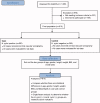Helicobacter pylori increases the risk of carotid plaque formation: a clinical evidence
- PMID: 34431440
- PMCID: PMC8405064
- DOI: 10.1080/07853890.2021.1927169
Helicobacter pylori increases the risk of carotid plaque formation: a clinical evidence
Abstract
Background and aim: Since the relation between Helicobacter pylori (H. pylori) and atherosclerosis has been evidenced, we aimed to analyze whether there is a relationship between the patient's H. pylori infection and age, gender, BMI, blood lipids, and carotid plaque formation.Methods: 810 patients from January 2016 to December 2019 were enrolled in this study, and divided the subjects into H. pylori (+) group and H. pylori (-) group based on the results of UBT. To analyze whether H. pylori infection is related to gender, age, BMI, blood lipids, and neck vascular plaque formation.Results: The single-factor analysis showed that the BMI ≥ 25kg/m2, triglycerides >1.7 mmol/l, the formation of cervical plaques were significantly higher in patients infected with H. pylori in compared to normal cases. Also, multi-variant logistic regression analysis showed that H. pylori infection affects the BMI ≥ 25kg/m2 and triglycerides >1.7 mmol/l to induce vascular plaque. Also, we showed that patients with H. pylori infection are 1.424 times higher than the non-infected group to have triglycerides more elevated than 1.7mmol/l.Conclusion: In this study, we conclude that H. pylori infection is an independent risk factor for higher BMI (>25), triglyceride (>1.7 mmol/l), and neck vascular plaque formation. The multi-variant analysis showed that patients with H. pylori infection are prone to have higher BMI, triglycerides, and neck vascular plaque formation over 1.4-times higher in non-infected individuals.KEY MESSAGESH. pylori infection is an independent risk factor for higher BMI, triglyceride, and neck vascular plaque formation.H. pylori can accelerate vascular plaque formation through increasing BMI and triglyceride.
Keywords: BMI; Helicobacter pylori; cervical vessel; dyslipidemia; lesion formation.
Conflict of interest statement
The authors declared they do not have anything to disclose regarding conflict of interest with respect to this manuscript.
Similar articles
-
Helicobacter pylori (H. pylori) infection in coronary artery disease: influence of H. pylori eradication on coronary artery lumen after percutaneous transluminal coronary angioplasty. The detection of H. pylori specific DNA in human coronary atherosclerotic plaque.J Physiol Pharmacol. 2001 Aug;52(1 Suppl 1):3-31. J Physiol Pharmacol. 2001. PMID: 11795863 Clinical Trial.
-
Helicobacter pylori infection as a risk factor for serum bilirubin change and less favourable lipid profiles: a hospital-based health examination survey.BMC Infect Dis. 2019 Feb 14;19(1):157. doi: 10.1186/s12879-019-3787-8. BMC Infect Dis. 2019. PMID: 30764765 Free PMC article.
-
Helicobacter pylori infection combined with non-alcoholic fatty liver disease increase the risk of atherosclerosis: Focus in carotid artery plaque.Medicine (Baltimore). 2019 Mar;98(9):e14672. doi: 10.1097/MD.0000000000014672. Medicine (Baltimore). 2019. PMID: 30817593 Free PMC article.
-
Helicobacter pylori infection and atherosclerosis: is there a causal relationship?Eur J Clin Microbiol Infect Dis. 2017 Dec;36(12):2293-2301. doi: 10.1007/s10096-017-3054-0. Epub 2017 Jul 27. Eur J Clin Microbiol Infect Dis. 2017. PMID: 28752210 Review.
-
Relationship between Helicobacter pylori infection and obesity in Chinese adults: A systematic review with meta-analysis.PLoS One. 2019 Sep 11;14(9):e0221076. doi: 10.1371/journal.pone.0221076. eCollection 2019. PLoS One. 2019. PMID: 31509542 Free PMC article.
Cited by
-
RNA Sequencing Reveals the Differentially Expressed circRNAs between Stable and Unstable Carotid Atherosclerotic Plaques.Genet Res (Camb). 2023 Mar 27;2023:7006749. doi: 10.1155/2023/7006749. eCollection 2023. Genet Res (Camb). 2023. PMID: 37020895 Free PMC article.
-
Infection with Helicobacter pylori may predispose to atherosclerosis: role of inflammation and thickening of intima-media of carotid arteries.Front Pharmacol. 2023 Oct 13;14:1285754. doi: 10.3389/fphar.2023.1285754. eCollection 2023. Front Pharmacol. 2023. PMID: 37900161 Free PMC article. Review.
-
Probiotics Bring New Hope for Atherosclerosis Prevention and Treatment.Oxid Med Cell Longev. 2022 Sep 24;2022:3900835. doi: 10.1155/2022/3900835. eCollection 2022. Oxid Med Cell Longev. 2022. PMID: 36193065 Free PMC article. Review.
References
Publication types
MeSH terms
Substances
LinkOut - more resources
Full Text Sources
Medical

